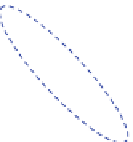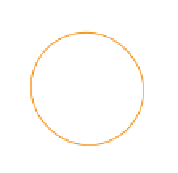Geoscience Reference
In-Depth Information
Fig. 7.3
Schematic plot
of a point current element,
d
,
immersed in a conducting
half-space
r
M
h
R
J
c
d
B
located in the conducting ground .
z
<0/. The total field in the ground is the sum of
the fields generated by the current element and its mirror image. Since more usually
we measure electromagnetic perturbations on the ground surface we shall exemplify
the field of current moment at
z
D
0. Let the point current element
d
be in the x
z
plane at the depth h in the homogeneous half-space with constant conductivity as
shown in Fig.
7.3
. Using the polar coordinate and , where the angle is measured
from x axis, the field components are written as follows (e.g., see Surkov et al.
2002
)
3d
z
h
C
d
x
2
2
h
2
cos
2R
5
d
x
sin
2R
3
;
E
D
;E
D
d
z
2h
2
2
C
3d
x
hcos
2R
5
E
z
.0
C
/
D
;E
z
.0
/
D
0;
R
R
C
h
;B
D
0
d
x
sin
4R
2
h
R
0
d
x
cos
4R.R
C
h/
;
B
D
;R
D
2
C
h
2
1=2
;
0
d
x
sin
4R
3
B
z
D
(7.6)
where d
x
and d
z
are projections of the vector
d
on the axes x and
z
, respectively.
Here E
z
.0
C
/ and E
z
.0
/ denote the vertical electric fields just above and below
the surface
z
D
0.
However, the simple formulas (
7.1
)-(
7.6
) can be used for order-of-magnitude
estimates of quasi-steady electromagnetic field generated by underground sources.
In Chap.
7
we study perturbations of the Earth's magnetic field caused by the
currents generated in the conducting rock or in the ionosphere. As we shall see, these
perturbations are related to the class of magneto-dipole type fields. By contrast, the
electrokinetic effects studied in Chap.
8
is usually related to the fields of the electric
dipole type.





































Search WWH ::

Custom Search